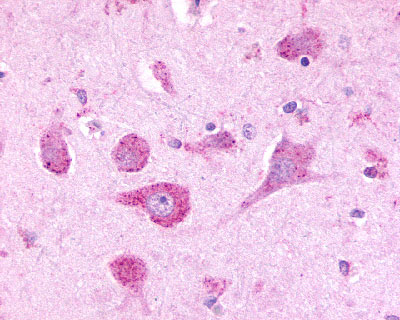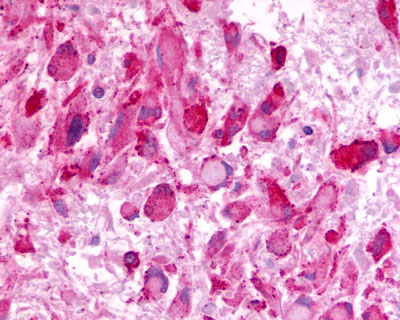ADGRL3 / LPHN3 Antibody (C-Terminus)
Rabbit Polyclonal Antibody
- SPECIFICATION
- CITATIONS
- PROTOCOLS
- BACKGROUND

Application
| IHC-P |
|---|---|
| Primary Accession | Q9HAR2 |
| Reactivity | Human, Mouse, Rabbit, Monkey, Chicken, Horse |
| Host | Rabbit |
| Clonality | Polyclonal |
| Calculated MW | 162kDa |
| Dilution | IHC-P (2 µg/ml) |
| Gene ID | 23284 |
|---|---|
| Other Names | Latrophilin-3, Calcium-independent alpha-latrotoxin receptor 3, CIRL-3, Lectomedin-3, LPHN3, KIAA0768, LEC3 |
| Target/Specificity | Human LPHN3. BLAST analysis of the peptide immunogen showed no homology with other human proteins. |
| Reconstitution & Storage | Long term: -70°C; Short term: +4°C |
| Precautions | ADGRL3 / LPHN3 Antibody (C-Terminus) is for research use only and not for use in diagnostic or therapeutic procedures. |
| Name | ADGRL3 {ECO:0000303|PubMed:35418682, ECO:0000312|HGNC:HGNC:20974} |
|---|---|
| Function | Orphan adhesion G-protein coupled receptor (aGPCR), which mediates synapse specificity (PubMed:35418682). Ligand binding causes a conformation change that triggers signaling via guanine nucleotide- binding proteins (G proteins) and modulates the activity of downstream effectors (PubMed:35418682). ADGRL3 is coupled with different classes of G alpha proteins, such as G(12)/G(13), G(s), G(i) or G(q), depending on the context (PubMed:35418682). Coupling to G(12)/G(13) G proteins, which mediates the activation Rho small GTPases is the most efficient (PubMed:35418682). Following G-protein coupled receptor activation, associates with cell adhesion molecules that are expressed at the surface of adjacent cells to direct synapse specificity (PubMed:26235030). Specifically mediates the establishment of Schaffer- collateral synapses formed by CA3-region axons on CA1-region pyramidal neurons in the hippocampus (By similarity). Localizes to postsynaptic spines in excitatory synapses in the S.oriens and S.radiatum and interacts with presynaptic cell adhesion molecules FLRT3 and TENM2, promoting synapse formation (By similarity). Plays a role in the development of glutamatergic synapses in the cortex (By similarity). Important in determining the connectivity rates between the principal neurons in the cortex (By similarity). |
| Cellular Location | Cell membrane; Multi-pass membrane protein. Postsynaptic cell membrane {ECO:0000250|UniProtKB:Q80TS3}; Multi-pass membrane protein. Cell projection, axon {ECO:0000250|UniProtKB:Q80TS3}. Cell junction {ECO:0000250|UniProtKB:Q80TS3} |
| Volume | 50 µl |

Thousands of laboratories across the world have published research that depended on the performance of antibodies from Abcepta to advance their research. Check out links to articles that cite our products in major peer-reviewed journals, organized by research category.
info@abcepta.com, and receive a free "I Love Antibodies" mug.
Provided below are standard protocols that you may find useful for product applications.
Background
May be involved in the development of glutamatergic synapses in the cortex. Important in determining the connectivity rates between the principal neurons in the cortex (By similarity).
References
Douangpanya J.,et al.Submitted (SEP-2000) to the EMBL/GenBank/DDBJ databases.
Hillier L.W.,et al.Nature 434:724-731(2005).
Ota T.,et al.Nat. Genet. 36:40-45(2004).
Nagase T.,et al.DNA Res. 5:277-286(1998).
Domene S.,et al.Am. J. Med. Genet. B Neuropsychiatr. Genet. 156:11-18(2011).
If you have used an Abcepta product and would like to share how it has performed, please click on the "Submit Review" button and provide the requested information. Our staff will examine and post your review and contact you if needed.
If you have any additional inquiries please email technical services at tech@abcepta.com.













 Foundational characteristics of cancer include proliferation, angiogenesis, migration, evasion of apoptosis, and cellular immortality. Find key markers for these cellular processes and antibodies to detect them.
Foundational characteristics of cancer include proliferation, angiogenesis, migration, evasion of apoptosis, and cellular immortality. Find key markers for these cellular processes and antibodies to detect them. The SUMOplot™ Analysis Program predicts and scores sumoylation sites in your protein. SUMOylation is a post-translational modification involved in various cellular processes, such as nuclear-cytosolic transport, transcriptional regulation, apoptosis, protein stability, response to stress, and progression through the cell cycle.
The SUMOplot™ Analysis Program predicts and scores sumoylation sites in your protein. SUMOylation is a post-translational modification involved in various cellular processes, such as nuclear-cytosolic transport, transcriptional regulation, apoptosis, protein stability, response to stress, and progression through the cell cycle. The Autophagy Receptor Motif Plotter predicts and scores autophagy receptor binding sites in your protein. Identifying proteins connected to this pathway is critical to understanding the role of autophagy in physiological as well as pathological processes such as development, differentiation, neurodegenerative diseases, stress, infection, and cancer.
The Autophagy Receptor Motif Plotter predicts and scores autophagy receptor binding sites in your protein. Identifying proteins connected to this pathway is critical to understanding the role of autophagy in physiological as well as pathological processes such as development, differentiation, neurodegenerative diseases, stress, infection, and cancer.



